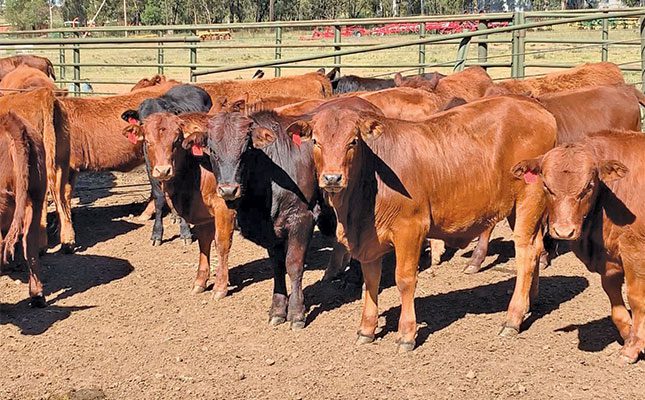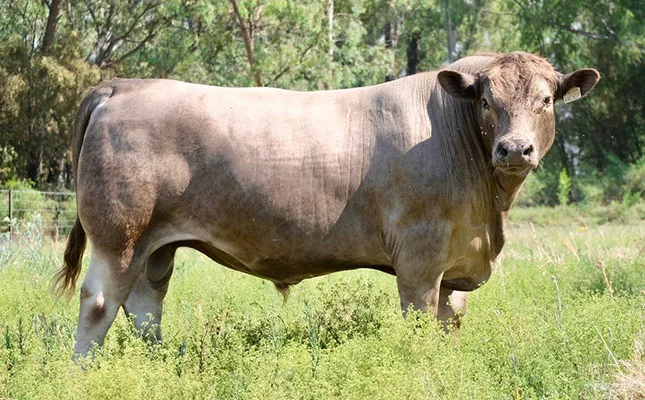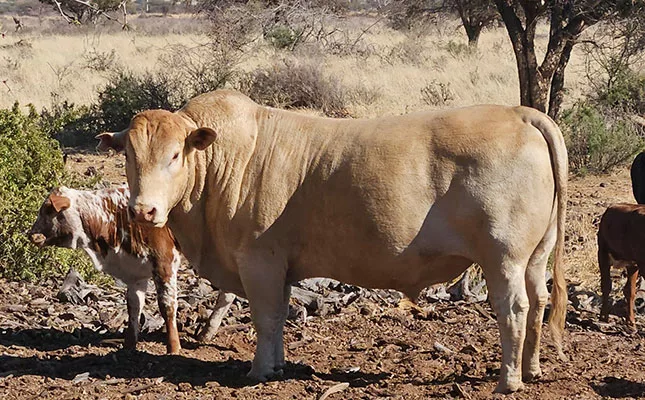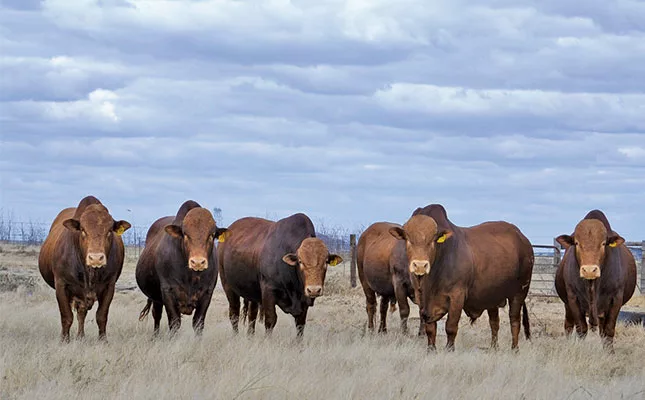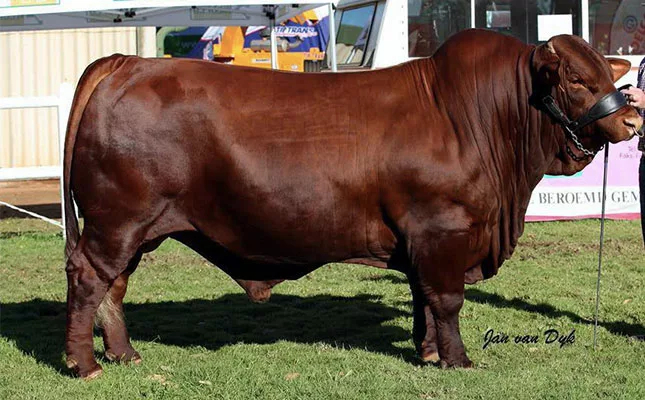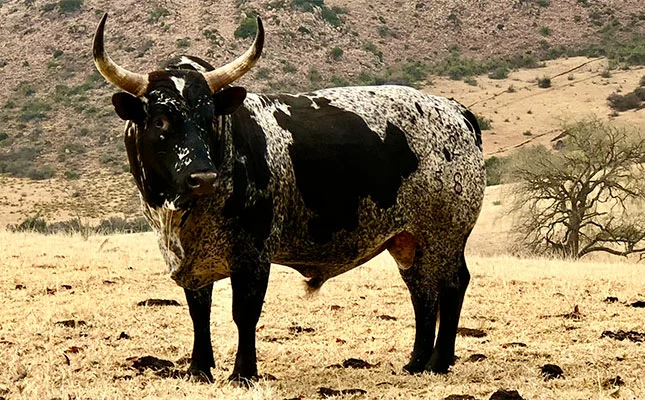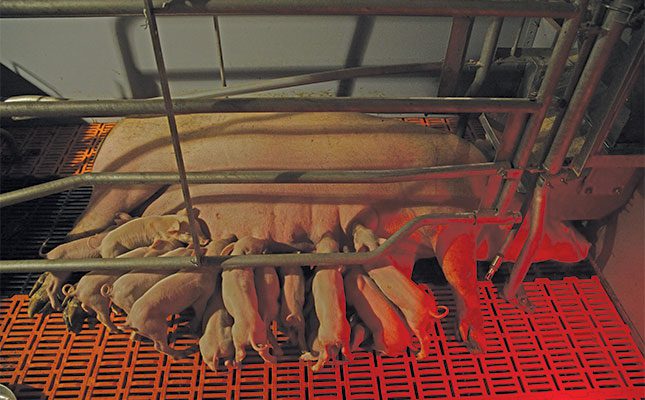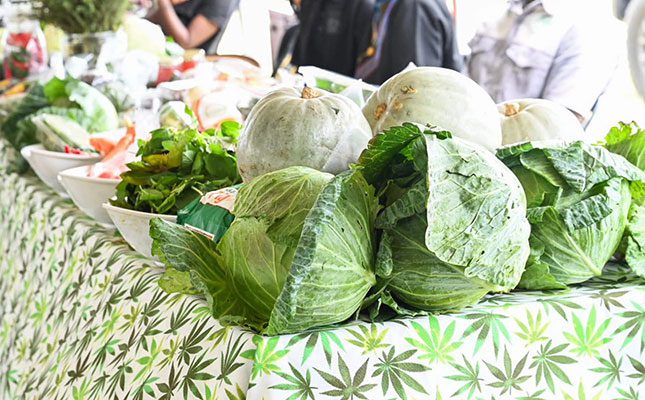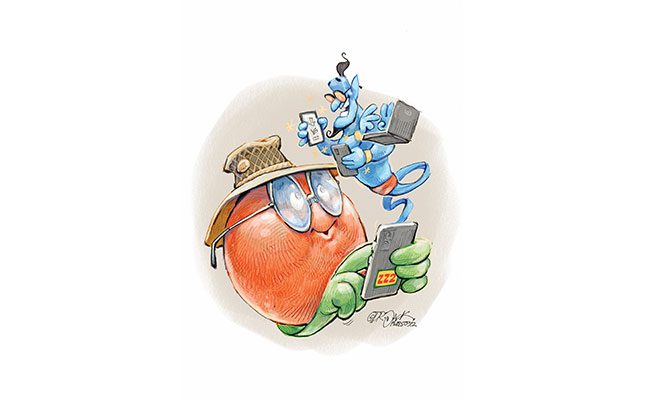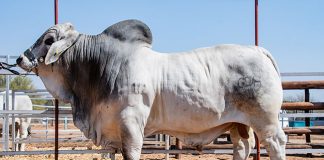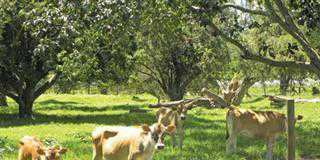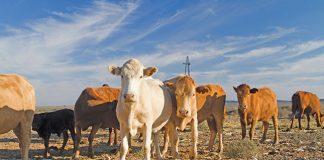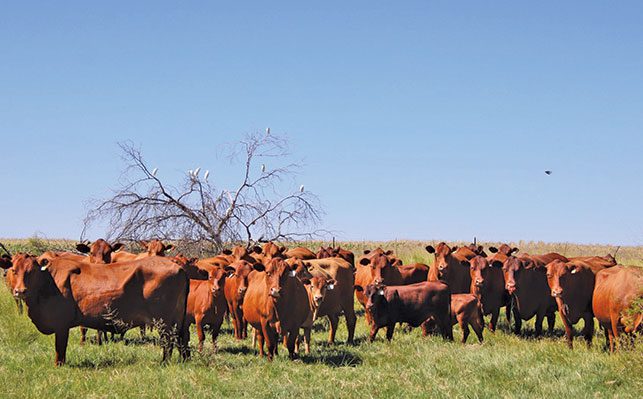
Photo: Senepol Cattle Breeders' Society of South Africa
Tiekie and Heleen Muller farm on the banks of the Vaal River near Bloemhof, on the Free State side. He runs a stud comprised of four bulls, 110 cows, and 35 heifers, and maintains an intercalving period of between 380 and 450 days. He also manages a 350-strong commercial herd, of which 200 of the cows belong to his son, NP.
Muller considers the medium-framed Senepol as the beef cattle breed of the future because of its popular solid-red colour and the fact that it is naturally polled, among other factors.
“The Senepol is an easy breed to work with because of its even temperament. The bulls’ fine, neat, and polled heads attracted me to the breed from the first time I laid my eyes on one. I strictly select for bulls with fine, masculine, and neat heads,” he says.
Bos Taurus
According to Muller, the Senepol, being genetically composed of a unique Bos taurus blend developed in isolation, has resulted in the ideal breed for crossbreeding due to their strong heredity factor. Between 80% and 100% of Senepol-cross calves are polled and will show the typical Senepol characteristics.
Muller explains that the Senepol-cross offspring always retain the typically uniform red colour of the Senepol, irrespective of the other breed it is crossed with. According to him, this is an added bonus as the majority of beef cattle buyers in the country prefer uniform red cattle, which markedly pushes up the demand for such animals.
“Due to the fact that the Senepol is a fixed breed with genetics unrelated to other breeds, they quickly influence other breeds through heterosis. The fact that the Senepol remained a true B. taurus makes it a valuable asset in the commercial beef cattle production industry,” he adds.
Heat tolerance
“Furthermore, it has the heat tolerance necessary to excel under extreme conditions. Senepol cattle don’t tend to seek shade during the midday heat, and it has been estimated that they graze around 1,25 hours longer per day than most other B. taurus breeds do,” he continues.
Previous studies have shown that Senepol cattle and their crosses with the Charolais and the Angus, among others, are as heat tolerant as Brahman cattle. This has been attributed to the Senepol’s slick coat of hair, which also adds to the breed’s outstanding resistance to ectoparasites.
The Senepol is a B. taurus composite originally bred on the Caribbean Island of St Croix. It was developed from the N’Dama, a beef cattle breed native to West Africa, and the Red Poll, while the Creole cattle on St Croix also made a contribution to its unique genetic make-up.
The first Senepols were bred by Bromley Nelthropp on the island in 1918. He laid the foundations for a breed of cattle that thrives in the island’s tropical environment and combines the traits needed for exceptional production.
The N’Dama cattle are a domestic breed that originated in the Guinea highlands in West Africa, and are also found in regions like southern Senegal, Mali, and The Gambia.
The naturally polled Red Poll is a dual-purpose breed suitable for milk and meat production. They were developed in England in the latter half of the 19th century, and The Red Poll Breeders’ Society of South Africa was formed in 1921.
Arrival in South Africa
The first Senepols arrived in South Africa in 2001, following the formation of the SA Senepol Club under the auspices of the Red Poll Cattle Breeders’ Society of South Africa in August 2000.
The Senepol Cattle Breeders’ Society of South Africa was established in October 2010 on the farm Bast Plaats in Vryburg, North West, almost 10 years after the first Senepol set foot on local soil.
In South Africa, Senepol breeding began with only three breeders, who collectively owned 31 females and six bulls. In the early days, due to the limited number of animals, embryo transplants were the easiest way to grow numbers.
Genetic material was very limited and was mostly imported from the US and used mainly on cows imported from Zimbabwe. The number of registered Senepol cattle now stands at close to 5 000 across 42 stud breeders in Southern Africa.
Cows and bulls
Muller extols the Senepol cow as the best beef cattle cow in Southern Africa. Senepol cows are sterling mothers with strong mothering instincts and producers of top-quality milk, which adds to their calves’ exceptional growth.
As stated in the 2024/25 Senepol Cattle Breeders’ Society journal, the genetic make-up from B. taurus breeds has resulted in a reproductively efficient animal. Senepol females exhibit good, visible signs of oestrus and when flushed, the average yield per Senepol cow is 6,5 usable embryos.
“The mothers are known for ease of calving, slick hair coating, adaptability, and outstanding fertility, among others. These attributes make them the best possible choice for beef producers. An added benefit of the breed is that Senepols have a greater immune response to disease when compared to other beef breeds. This is likely due to the generations of natural selection on the island of St Croix,” says Muller.
The breed is known for exceptional fertility and milk production. Cows produce enough milk to wean calves at 40% to 50% of their own weight. The average birthweight maintained by the Nooitgedacht stud is 28kg for female calves and between 32kg and 33kg for male calves, with a weaning weight of between 180kg and 220kg at seven months. The Senepol is an early-maturing breed and the heifers are put to the bull at 16 months.
Although Muller seldom makes use of artificial insemination (AI), a group of 16-month-old heifers were inseminated with semen imported from Puerto Rico on the day of Farmer’s Weekly’s visit to the stud.
Says Muller: “The introduction of the Puerto Rican genetics was needed to extend, not improve, the genetic base of the breed. Although the Southern African Senepol genetics are highly regarded internationally, it is always wise to increase diversity.”
According to him, it is the responsibility of stud breeders to market the best of the best genetics to the beef production value chain. His dedication to the provision of top genetics is evident in the fact that Muller paid a record price of R165 000 for the bull CS 21 052 at the national Senepol sale held in Excelsior last year.
The bull was bred by Chris and Rose Sheard from Cathcart. At the time, Chris described CS 21 052 as a well-balanced animal and an “all-rounder of a bull”.
Senepol bulls are aggressive breeders with excellent scrotal circumferences and high libidos.
“For me, the ideal Senepol bull is medium framed, well boned and shows character and masculinity. Reproductive efficiency is of the essence,” explains Muller.
The majority of bulls produce top-quality semen by the age of 12 to 14 months. The penile sheath is neat, which helps avoid injuries that often result from excessively pendulous sheaths.
Feedlot performance
The Senepol excels in the feedlot and is known to show an average daily gain of 2kg/ day under such conditions, says Muller.
“Senepols and animals crossbred with them are renowned for high-quality beef with excellent marbling, tenderness, and flavour. They have efficient feed conversion rates and can thrive on lower-quality forage, increasing the breed’s viability under the most taxing conditions, such as in the semi-arid Namibia,” he adds.
Genomic testing of the Senepol in South Africa has shown that the genetic make-up of the breed is quite unique, especially in the single-gene category.
Boetie Hattingh, president of the Senepol Cattle Breeders’ Society of South Africa, says that in addition to being polled, the Senepol is also the only breed in South Africa that has the slick hair gene, which can be successfully used to obtain a slick hair coat in crossbreeding with hirsute cattle.
“Genetic results further showed that the Senepol is currently the only breed with the ability to obtain a meat tenderness score on gene level of 5/6, with six being the most tender.
Other tested breeds score 3/6 for meat tenderness. This also mean that the Senepol can be used to improve meat tenderness through focused breeding programmes,” he explains.
Senepol cattle have a natural resistance to common cattle diseases prevalent in South Africa, including tick-borne diseases and tropical parasites. Despite the breed’s outstanding disease resistance, Muller follows a comprehensive herd health protocol, including vaccination against lumpy skin disease and Rift Valley fever.

